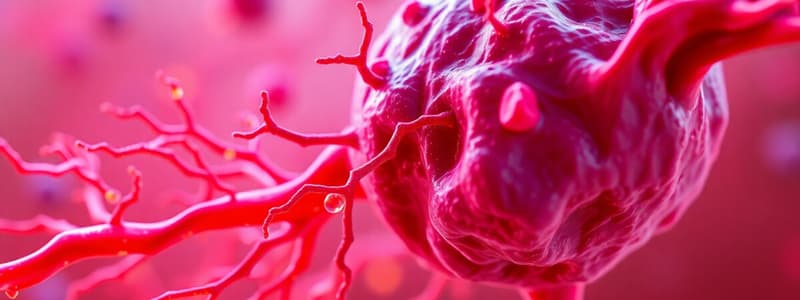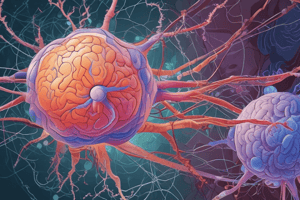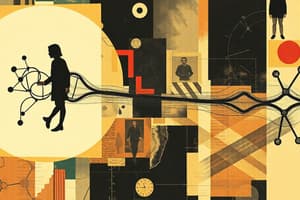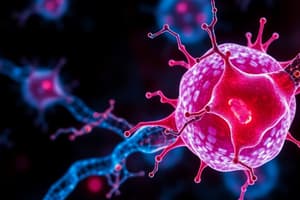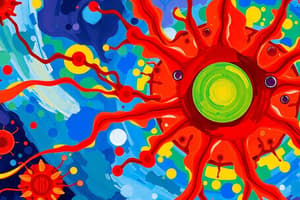Podcast
Questions and Answers
What is the primary outcome of a signal transduction pathway?
What is the primary outcome of a signal transduction pathway?
- Regulation of one or more cellular activities (correct)
- Cellular apoptosis
- Replication of DNA
- Transport of molecules across membranes
Where do many signaling pathways exert their effects on protein synthesis?
Where do many signaling pathways exert their effects on protein synthesis?
- Mitochondria
- Nucleus (correct)
- Cell membrane
- Cytoplasm
Which of the following accurately describes the role of the final activated molecule in a signaling pathway?
Which of the following accurately describes the role of the final activated molecule in a signaling pathway?
- It functions as an energy carrier.
- It acts as a receptor on the cell membrane.
- It serves as a transcription factor. (correct)
- It transports enzymes across the cytoplasm.
Which pathway type is responsible for regulating the activity rather than the synthesis of enzymes?
Which pathway type is responsible for regulating the activity rather than the synthesis of enzymes?
Which component is essential for the transduction phase of a signaling pathway?
Which component is essential for the transduction phase of a signaling pathway?
What is the first stage of cell signaling as suggested by Earl W. Sutherland?
What is the first stage of cell signaling as suggested by Earl W. Sutherland?
Which of the following accurately describes the role of a signaling molecule in cell signaling?
Which of the following accurately describes the role of a signaling molecule in cell signaling?
What characterizes the binding between a signaling molecule and its receptor?
What characterizes the binding between a signaling molecule and its receptor?
Which type of receptor is not one of the three main types of membrane receptors?
Which type of receptor is not one of the three main types of membrane receptors?
How does the shape change in a receptor influence cell signaling?
How does the shape change in a receptor influence cell signaling?
What happens during the transduction phase of cell signaling?
What happens during the transduction phase of cell signaling?
In which stage of cell signaling does the activation of a cellular response occur?
In which stage of cell signaling does the activation of a cellular response occur?
Which type of signaling molecules typically bind to receptors that span the plasma membrane?
Which type of signaling molecules typically bind to receptors that span the plasma membrane?
What happens when a signal molecule binds to a ligand-gated ion channel receptor?
What happens when a signal molecule binds to a ligand-gated ion channel receptor?
What is the role of activated receptor tyrosine kinase proteins?
What is the role of activated receptor tyrosine kinase proteins?
Which of the following describes the state of receptor tyrosine kinase proteins before ligand binding?
Which of the following describes the state of receptor tyrosine kinase proteins before ligand binding?
What triggers the activation of relay proteins in the signaling pathway?
What triggers the activation of relay proteins in the signaling pathway?
Which ions can pass through a ligand-gated ion channel receptor when activated?
Which ions can pass through a ligand-gated ion channel receptor when activated?
What defines a fully activated receptor tyrosine kinase dimer?
What defines a fully activated receptor tyrosine kinase dimer?
Which part of the receptor tyrosine kinase structure directly interacts with the signaling molecule?
Which part of the receptor tyrosine kinase structure directly interacts with the signaling molecule?
What results from the activation of tyrosine kinase regions in the signaling pathway?
What results from the activation of tyrosine kinase regions in the signaling pathway?
What is the role of Fus3 in the phosphorylation cascade?
What is the role of Fus3 in the phosphorylation cascade?
Which aspect of cell signaling does 'fine-tuning' NOT refer to?
Which aspect of cell signaling does 'fine-tuning' NOT refer to?
How does enzyme cascades contribute to cell signaling?
How does enzyme cascades contribute to cell signaling?
What is one function of scaffolding proteins in cell signaling?
What is one function of scaffolding proteins in cell signaling?
What can occur due to pathway branching in cell signaling?
What can occur due to pathway branching in cell signaling?
How do different types of cells respond to the same signaling molecule?
How do different types of cells respond to the same signaling molecule?
Which of the following statements about signal termination is true?
Which of the following statements about signal termination is true?
What best describes the concept of signal amplification in cell signaling?
What best describes the concept of signal amplification in cell signaling?
What role does inositol triphosphate (IP3) play in cell signaling pathways?
What role does inositol triphosphate (IP3) play in cell signaling pathways?
Which component is NOT involved in the release of calcium from the endoplasmic reticulum?
Which component is NOT involved in the release of calcium from the endoplasmic reticulum?
What triggers the signaling pathways leading to increased calcium levels in the cytosol?
What triggers the signaling pathways leading to increased calcium levels in the cytosol?
Which molecule acts as the first messenger in the signaling process?
Which molecule acts as the first messenger in the signaling process?
What is the relationship between DAG and the signaling pathways discussed?
What is the relationship between DAG and the signaling pathways discussed?
Which process represents the 'output response' of a cell to an extracellular signal?
Which process represents the 'output response' of a cell to an extracellular signal?
How does the cell increase intracellular calcium concentration according to the provided content?
How does the cell increase intracellular calcium concentration according to the provided content?
Which of the following accurately describes the mechanism of signal transduction involving calcium?
Which of the following accurately describes the mechanism of signal transduction involving calcium?
What is the primary function of the G protein in the signaling mechanism?
What is the primary function of the G protein in the signaling mechanism?
What is the primary function of apoptosis during embryonic development in organisms such as Caenorhabditis elegans?
What is the primary function of apoptosis during embryonic development in organisms such as Caenorhabditis elegans?
Which protein inhibits the activity of Ced-4 in the apoptotic pathway of C. elegans?
Which protein inhibits the activity of Ced-4 in the apoptotic pathway of C. elegans?
What are caspases primarily responsible for in the process of apoptosis?
What are caspases primarily responsible for in the process of apoptosis?
What triggers apoptosis in Caenorhabditis elegans?
What triggers apoptosis in Caenorhabditis elegans?
What happens to Ced-4 when a death signal is present in the apoptotic pathway?
What happens to Ced-4 when a death signal is present in the apoptotic pathway?
Which of the following statements is true regarding Ced-9 protein in the absence of a death signal?
Which of the following statements is true regarding Ced-9 protein in the absence of a death signal?
What is formed as a result of active Ced-4 and Ced-3 in the apoptotic process?
What is formed as a result of active Ced-4 and Ced-3 in the apoptotic process?
Which element of the apoptotic pathway indicates that a death signal has been received?
Which element of the apoptotic pathway indicates that a death signal has been received?
Flashcards
Reception
Reception
The process by which a cell detects a signaling molecule from the environment.
Transduction
Transduction
The process by which a cell converts an external signal into a form that can trigger a specific cellular response.
Response
Response
The specific cellular response to the signal molecule.
Ligand
Ligand
Signup and view all the flashcards
Receptor
Receptor
Signup and view all the flashcards
G Protein-Coupled Receptor
G Protein-Coupled Receptor
Signup and view all the flashcards
Receptor Tyrosine Kinase
Receptor Tyrosine Kinase
Signup and view all the flashcards
Ion Channel Receptor
Ion Channel Receptor
Signup and view all the flashcards
Receptor tyrosine kinase (RTK)
Receptor tyrosine kinase (RTK)
Signup and view all the flashcards
Signal transduction
Signal transduction
Signup and view all the flashcards
Tyrosine phosphorylation
Tyrosine phosphorylation
Signup and view all the flashcards
Dimer
Dimer
Signup and view all the flashcards
Relay protein
Relay protein
Signup and view all the flashcards
Ligand-gated ion channel receptor
Ligand-gated ion channel receptor
Signup and view all the flashcards
Inositol Triphosphate (IP3)
Inositol Triphosphate (IP3)
Signup and view all the flashcards
Diacylglycerol (DAG)
Diacylglycerol (DAG)
Signup and view all the flashcards
Transcription Factor
Transcription Factor
Signup and view all the flashcards
Nuclear Response
Nuclear Response
Signup and view all the flashcards
Cytoplasmic Response
Cytoplasmic Response
Signup and view all the flashcards
Phosphorylation Cascade
Phosphorylation Cascade
Signup and view all the flashcards
Signal Amplification
Signal Amplification
Signup and view all the flashcards
Specificity of Cell Signaling
Specificity of Cell Signaling
Signup and view all the flashcards
Pathway Branching and Cross-talk
Pathway Branching and Cross-talk
Signup and view all the flashcards
Scaffolding Proteins
Scaffolding Proteins
Signup and view all the flashcards
Signal Termination
Signal Termination
Signup and view all the flashcards
Formin
Formin
Signup and view all the flashcards
Fus3
Fus3
Signup and view all the flashcards
Apoptosis
Apoptosis
Signup and view all the flashcards
Role of apoptosis in development
Role of apoptosis in development
Signup and view all the flashcards
Apoptotic 'accelerator' and 'brake' proteins
Apoptotic 'accelerator' and 'brake' proteins
Signup and view all the flashcards
Ced-9 protein
Ced-9 protein
Signup and view all the flashcards
Ced-4 protein
Ced-4 protein
Signup and view all the flashcards
Ced-3 protein
Ced-3 protein
Signup and view all the flashcards
Caspases
Caspases
Signup and view all the flashcards
Death-signaling ligands
Death-signaling ligands
Signup and view all the flashcards
Study Notes
Cell Communication Overview
- Cell-to-cell communication is vital for both multicellular and unicellular organisms.
- Scientists have identified common mechanisms for cellular regulation.
- Cells often communicate chemically.
- For instance, the "fight-or-flight" response is triggered by the signaling molecule epinephrine.
- External signals are processed inside the cell.
- Microbes are a resource for understanding the role of cell signaling in evolution.
Evolution of Cell Signaling
- The yeast Saccharomyces cerevisiae has two mating types: a and α.
- Cells of different mating types find each other through specific secreted factors.
- A signal transduction pathway involves a series of steps converting a surface signal into a cellular response.
- Signal transduction pathways translate surface signals into cellular responses.
Local and Long-Distance Signaling
- Cells in multicellular organisms communicate using chemical messengers.
- Animal and plant cells have specialized junctions to connect their cytoplasms.
- Local signaling in animal cells can be triggered by direct contact or recognition.
- In many instances, animal cells use local regulators for communication.
- Plant and animal cells use hormones for long-distance signaling.
- A cell's response depends on whether it has specific receptors for the signal.
Types of Signaling
- Paracrine signaling: A cell releases a signal to influence nearby cells, changing their behaviour.
- Endocrine signaling: Hormones travel through the bloodstream to target cells, causing a slower, sustained response.
- Synaptic signaling: A specialized structure called a synapse connects the signaling cell and receiving cell. This type of signaling occurs only between cells with synapses, such as a neuron and muscle cell.
Three Stages of Cell Signaling
- Earl W. Sutherland discovered how the hormone epinephrine affects cells.
- Cellular responses to signals involve three stages: reception, transduction, and response.
Reception
- Binding between a signal molecule and receptor is highly specific.
- A shape change in the receptor often initiates signal transduction.
- Most signal receptors are plasma membrane proteins.
Receptors in the Plasma Membrane
- Most water-soluble signaling molecules bind to specific sites on receptor proteins that span the plasma membrane.
- There are three main types of membrane receptors: G protein-coupled receptors, receptor tyrosine kinases, and ion channel receptors.
G Protein-Coupled Receptors (GPCRs)
- GPCRs are the largest family of cell-surface receptors.
- A GPCR is a plasma membrane receptor that interacts with a G protein.
- The G protein acts as a molecular switch. If GDP is bound, the G protein is inactive.
Receptor Tyrosine Kinases (RTKs)
- RTKs are membrane receptors that attach phosphates to tyrosines.
- A single RTK can trigger multiple signal transduction pathways.
- Abnormal RTK function is linked to many cancers.
Ligand-Gated Ion Channel Receptors
- These receptors act as gates when a signal molecule (ligand) changes their shape.
- The gate allows specific ions (e.g., Na+ or Ca2+) through a channel in the receptor.
Intracellular Receptors
- Intracellular receptor proteins are located in the cytosol or nucleus of target cells.
- Small or hydrophobic chemical messengers can readily cross the membrane and activate receptors.
- Steroid and thyroid hormones are examples of hydrophobic messengers.
- An activated hormone-receptor complex acts as a transcription factor to turn on specific genes.
Signal Transduction: Cascades
- Signal transduction usually involves multiple steps.
- Multistep pathways amplify the signal, allowing a few molecules to trigger a large cellular response.
- Multistep pathways offer opportunities for coordination and control of cellular responses.
- Signal transduction relies primarily on protein molecules like dominoes; one triggers another, until the final protein is activated.
- At each cascade step, the signal changes form, typically as a protein shape change.
Protein Phosphorylation and Dephosphorylation
- Many pathways utilize protein phosphorylation cascades.
- Protein kinases transfer phosphates from ATP to a protein, a process called phosphorylation.
- Protein phosphatases remove phosphates from proteins, dephosphorylating them; this system works like a molecular switch, turning activities on and off as required .
Small Molecules and Ions as Second Messengers
- The extracellular signaling molecule (ligand) is the "first messenger".
- Second messengers are small, non-protein water-soluble molecules or ions that spread through a cell by diffusion.
- Second messengers participate in pathways started by GPCRs and RTKs.
- Cyclic AMP (cAMP) and calcium ions are common second messengers.
Cyclic AMP (cAMP)
- cAMP is a frequently used second messenger.
- Adenylyl cyclase, a plasma membrane enzyme, converts ATP to cAMP in response to extracellular signals.
Calcium Ions and Inositol Triphosphate (IP3)
- Calcium ions (Ca2+) are a second messenger in many pathways.
- Cells regulate Ca2+ concentration, making it an important second messenger.
- Pathways releasing Ca2+ involve IP3 and diacylglycerol (DAG) as additional second messengers.
Response
- A cell's output response is its reaction to the extracellular signal.
- Signal transduction pathways often regulate the synthesis or activity of enzymes or other proteins, usually by controlling gene expression in the nucleus.
- The final activated molecule in the pathway often acts as a transcription factor.
- Other pathways control enzyme activity.
Apoptosis
- Apoptosis is programmed cell death.
- During apoptosis, cellular components are broken down and packaged in vesicles for digestion by scavenger cells.
- Apoptosis prevents enzymes from leaking out, preventing damage to surrounding cells.
- Apoptosis is important during embryonic development and maintenance of animals.
- Apoptosis can be involved in diseases like Parkinson's and Alzheimer's, and interference with apoptosis can contribute to cancers.
Fine-Tuning of the Response
- Four key aspects fine-tune responses: signal amplification, specificity, efficiency, and termination of the signal.
Signal Amplification
- Enzyme cascades amplify a cellular response.
- Activated product numbers increase significantly at each step in the cascade.
Specificity of Cell Signaling
- Different cells have different protein collections, allowing them to respond differently to signals.
- The same signal may have different effects in cells with different proteins and pathways.
- Pathway branching and cross-talk help cells coordinate incoming signals.
Signaling Efficiency: Scaffolding Proteins
- Scaffolding proteins are large relay proteins to which other relay proteins attach.
- They increase signaling pathway efficiency by bringing together proteins involved in the same pathway.
- They may also activate some of the relay proteins.
Termination of the Signal
- Signal termination mechanisms are essential for cell signaling.
- If ligand concentration decreases, fewer receptors bind.
- Signalling molecules are degraded to terminate the signal.
Studying That Suits You
Use AI to generate personalized quizzes and flashcards to suit your learning preferences.
